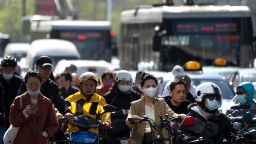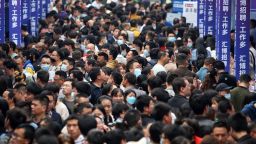Holiday spending during China’s Golden Week has surged past pre-pandemic levels for the first time in three years, in a sign the country’s travelers have fully emerged from the depths of Covid-related restrictions and are eager to live large to make up for lost time.
For many, this May Day period, spanning five days from April 29 to May 3, was the first chance to go on vacation in more than three years, without having to worry about catching Covid. During the Chinese New Year holiday in January, many people stayed home because of fears of infection during China’s “exit wave” when an unknown number of people caught the disease.
Travelers made 274 million trips within mainland China during the holiday, up 71% from a year ago and 19% higher than 2019, according to data from the Ministry of Culture and Tourism on Wednesday. Revenue from domestic tourism reached 148 billion yuan ($21 billion), up 129% from a year earlier and also slightly higher than 2019.

Many tourist attractions were much more crowded this week than during previous long holidays. Reports and photos of too many people crammed into buses, bridges or restaurants are all over social media.
“This May Day is crazy!” was a popular hashtag on Weibo, China’s verison of Twitter. Many travelers complained online that they could only see other people’s heads during visits to tourist attractions during the holiday, which is also known as Labor Day.
Some said there were so many tourists in Changsha, a city in the southern province of Hunan, that the wait list for a popular dinner spot had more than 300 people at one point. To attend a music festival in the city, some even set up a tent outside the venue overnight to secure a spot in the line.
“This is the worst holiday experience ever,” many complained on Weibo.
China’s vast railway network, a major mode of transportation, saw a record 120 million trips made from April 27 to May 4, up 20% from the same period in 2019, the national railway operator announced.

Economic boost
Services-related consumption staged a major rebound this week.
Revenues reported by dining and retail companies jumped nearly 20% during the holiday, data from the Ministry of Commerce indicated. It’s a significant increase, as retail sales growth was just 10.6% in March.
Alipay, the country’s biggest digital payment app, reported a 200% increase in online holiday spending from a year earlier. The amount was also 70% higher than the 2019 level.
“Revenge travel boom [is] in play,” said Citi analysts. “With the latest pulse check, China’s services recovery, especially for offline services and long-haul travels, is well on track.”
“The strong Labor Day holiday tourism data bodes well for consumption and services recovery in coming months, and adds conviction to our above-consensus 2023 GDP growth forecast [of 6%],” Goldman Sachs analysts wrote on Thursday.
But other analysts are more cautious, as signs point to an uneven recovery in the Chinese economy.
Weakness in manufacturing
The Caixin/S&P Global PMI index unexpectedly shrank in April, dropping to 49.5 from 50 in March, a private survey showed on Thursday. This was the first contraction recorded in the manufacturing sector in two months, as factories wound down production amid weak demand and high inventory levels.
The index, which targets smaller private firms, was in line with a government survey released this week, which showed that factory activity at large state-owned enterprises unexpectedly cooled last month.
“The fact that domestic tourism spending is now back to 2019 levels suggests that the reopening boost to consumer spending has largely run its course,” said Capital Economics analysts in a Thursday report.
But “the manufacturing sector faces challenges from the weak global outlook.”
Nomura analysts also believe growth in in-person services could drop in coming months as pent-up demand wanes.
“The swift recovery in in-person services has been the major driver of China’s post-Covid recovery this year,” they said.
However, “the lackluster property recovery, a global slowdown and rising geopolitical conflict remain major challenges for China’s recovery to be sustained.”











